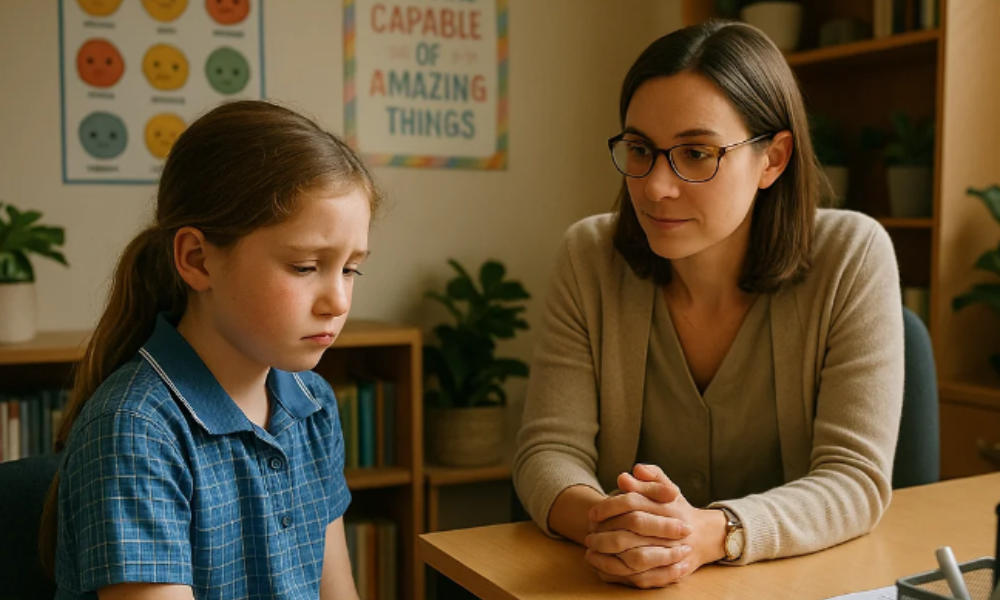
One in five children across Australia lives with chronic pain – and while their suffering often goes unseen, its impact can echo through every corner of the classroom.
From migraines and juvenile arthritis to ongoing stomach pain, students are grappling with more than just physical symptoms. For teachers, this means juggling lesson plans with fatigue, concentration issues, emotional distress and the need to accommodate frequent breaks.
But new research reveals it’s not just students feeling the weight of these conditions – teachers are struggling, too.
A study led by physiotherapist and UTS PhD student Rebecca Fechner has shed light on the hidden pressures educators face as they try to support students with chronic pain. The findings show that while awareness around student pain is growing, many teachers feel unprepared and emotionally drained as they try to meet their students’ needs with little guidance or support.
“Teachers are deeply committed to their students’ wellbeing,” says Ms Fechner, who will graduate with her PhD in October. “But when it comes to pain, they’re often left to navigate complex situations without training or guidance, relying on instinct and personal experience.”
Teachers feel helpless
Recently published in Paediatric and Neonatal Pain, the study involved interviews with eleven teachers across primary and secondary schools. It found that educators frequently feel helpless, emotionally drained, and unsupported when trying to respond to student pain, particularly when symptoms are medically unexplained.
One teacher said: “I can only do what I can do based on my experience,” noting that managing student pain is common, but not something she has ever been taught. Others spoke of sacrificing their own wellbeing to support students, working through lunch breaks, or losing sleep over whether they had responded appropriately.
“I wake up in the middle of the night, sometimes being like: ‘Did I say that thing right? Did I do that thing right?’” said one participant. “I just question whether or not I had done the right thing”.
The research identifies three key areas where pain science education can create meaningful change for both teachers and students:
• Teacher-student relationships: Because pain is a social experience, relationships can positively change pain outcomes. Teachers already possess empathy and communication skills that can be harnessed with targeted training.
• School culture and policy: A collective understanding of the biopsychosocial nature of pain can optimise existing inclusive policies and supportive environments in schools.
• Societal beliefs: Misconceptions about pain, such as the idea that children exaggerate or that pain must be visible, need to be addressed through pain science education.
“Teachers want to help,” says Fechner. “But they need time, training, and support. We must equip them with knowledge about pain science, and a framework to respond to their students with curiosity and validation.”
Pain awareness training needed
The study calls for pain awareness to be integrated into teacher training, school policy, and public health initiatives, recognising pain as a legitimate barrier to learning and empowering teachers to be part of the solution.
“Pain is complex, but our response doesn’t have to be,” says Fechner. “With empathy, education, and collaboration, we can make schools safer and more supportive for every student and every teacher.”
Building on the findings of this study, Fechner’s PhD research explores how pain science can be embedded into the school curriculum through a teacher-led approach.
In collaboration with two pilot schools in Queensland and New South Wales, she has codesigned Australia’s first teacher-led pain science education program for teachers and students.
Teachers were provided with foundational content about how the nervous system works and the factors that influence pain and were supported to integrate it into subjects like health and science. The program also encouraged discussion of the social aspects of pain and helping students learn how to support peers.
By placing teachers at the centre of the initiative, the program aims to improve health literacy and reshape how school communities understand and respond to chronic pain.
Fechner said it’s not just about teaching children.
“By educating teachers, we empower them to lead and inspire a new generation of students with the skills to better understand and support those in pain.”
The original version of this story was first published as a media release from the University of Technology Sydney.

